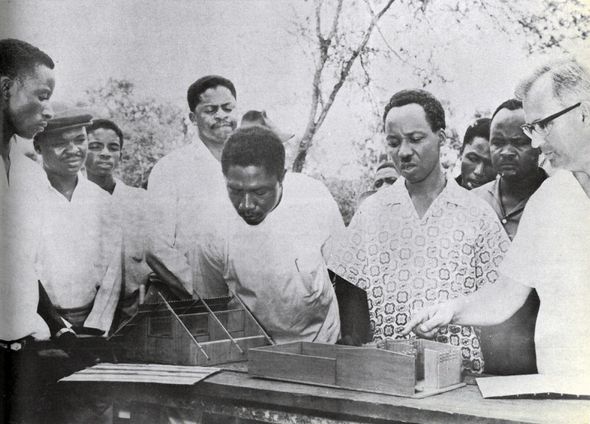In the Name of Development. Architecture and Training for Human Settlements in Sweden, 1960-80s

This one-year research project at KTH Stockholm coincides with the start of a broader research project that aims to chart the hitherto little understood role of architectural schools, centers, and institutes in contributing to the 1960-80s ‘development’ agenda of various governmental and non-governmental bodies by offering ‘South-oriented’ training programs, established in order to take training in architecture, urbanism, and spatial planning as leverage tools for broader development.
In the wake of a global turn towards ‘development aid’, and the UN’s gradually increasing attention towards the built environment as a crucial factor in fostering ‘development’, in the 1970s many institutes (research and/or education) were founded with the explicit intention to mobilize architectural and urbanistic expertise for development goals. The social, political and environmental aspirations with which architecture was invested in this increasingly global mindset – epitomized by the UN conferences on the Human Environment (Stockholm 1972) and on Human Settlements (Vancouver 1976, a.k.a. Habitat I) – undoubtedly posed renewed challenges to the discipline of architecture.
Recently, a wide range of vantage points have been taken to chart and critically assess architecture’s role in taking up these challenges. Some of these are centered on key protagonists or on specific projects, sketch out the history of Human Settlements as a discipline, or provide a thorough analysis from the standpoint of global governance. Despite these impressive efforts, the many institutes that have emerged out of this context within, or in cooperation with, many schools of architecture, barely register as a topic of interest in their own right. Though a few of these institutes have been active in documenting their own histories (often in the form of timelines), critical accounts of such institutional history of architecture in the ‘development’ years are currently limited to a couple of high profile institutes: mainly the Development Planning Unit (DPU) in London and the MIT-Harvard Joint Center for Urban Studies. The educational programs that were set up within the frameworks of such institutes, in collaboration with development agencies and targeted at ‘Third World’ professionals, received even less attention.
Yet, studies such as those by Jiat-Hwee Chang and Vandana Baweja on the DPU’s predecessor evidence the importance of such lines of inquiry. They show how much such institutes and educational programs were not only important factors in the contemporary figuration of the so-called Global South, but that they also were hybrid places of encounter, often fostering a stimulating intellectual climate that had repercussions for architectural culture as a whole, far beyond the walls of the institute, and far from limited to ‘the South’.
By now, many of these have ceased to exist or have been transformed to unrecognizable extents. Unfortunately, despite numerous protagonists still alive, their histories are mostly left unwritten – let alone that these histories are taken to critically reflect on how architectural thought had and has to manoeuvre in between conflicting demands, part-time engagements, asymmetric power relations, a globalizing discourse, stringent financial pragmatism and the high hopes of serving a good cause.
A case in point is the Post Graduate Centre for Human Settlements (PGCHS) in Leuven, Belgium. It was established in the 1970s and organized a unique UN-mandated ‘Housing in Development’ training program for Asian and African mid-career professionals during the 1980s. More or less by chance was I drawn to its history when writing my PhD on a quite different subject: the history of architectural theory in Belgium. Whilst investigating the various guises of the gradually maturing discipline of architectural theory, I came to realize that architectural theory in Leuven was strongly shaped by the protagonists’ experiences with the Global South through their involvement in the PGCHS. Further, in elaborating a chapter on this entanglement between architectural theory and the history of this center, I learned that the PGCHS was only one exemplar of what was in fact a widespread phenomenon: from the 1970s onwards, most governments in Western countries (but also in state-socialist ones) opted to invest parts of their ‘development aid’ budgets in offering South-oriented training programs in architecture, urbanism, and planning. This political phenomenon resulted in an institutional landscape of generally one or two centers per country where the required expertise for such a training mandate was gathered, and from where this expertise also had many (often overlooked) spillover effects to the wider, domestic architecture culture.
But in elaborating the PGCHS case, I also realized how little documentation, scholarship, and frankly, historical understanding, on and of such institutes actually exists. Hence the larger project outlined above that aims to understand the role such institutes played in a globalizing architectural culture. Eventually this will result in the first comprehensive book to take a bird’s eye view on the institutional landscape and historical role of South-oriented training programs at architectural schools, institutes, and centers in the 1960-80s development endeavor.
In developing a comparative, European perspective on the matter, at KTH Stockholm this broader research project starts with gaining a thorough understanding of how this phenomenon played out in Sweden by engaging with existing and ongoing scholarship on the history of Swedish development programs and of Swedish architectural education. Thus, it will contribute to constructing an overall picture of how Sweden fits into this global phenomenon: how architecture schools such as Lund University, Chalmers University of Technology, and KTH Stockholm, have assisted in the development endeavor, what networks they upheld and which specific in-house expertise they generated; as well as what training programs were being developed in this context.
Image: Bertil Melin, the Swedish director of the Nordic Tanganyika Project in Kibaha, showing a model of low-cost housing to President Julius Nyerere, c. 1963-64. To the far left, Mr. Dennis, the carpenter who made the models, co-designed the housing project, and “test-lived“ in the first constructed house with his family. From Torvald Åkesson, ‘Education - In Marble Halls or Under Trees. Low-Cost Houses in East Africa, Especially Ethiopia and Tanzania’, compiled self-published report, c. 1965, Stockholm. Collection KTH Library.